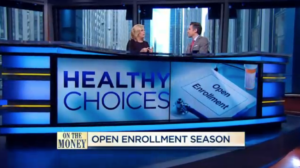 It’s that time of year again for many employees: open enrollment for group benefits. This means you have a relatively small window of time to select or change the various elections offered to you. My friends at CNBC were kind enough to invite me back to On The Money to discuss the topic. You can watch that here. So, in the spirit of open enrollment, let’s review some key things you should keep in mind this election season (pun intended). BTW – I’ve hyperlinked some financial terms to Investopedia, should you wish to learn more about any particular benefit/term.
It’s that time of year again for many employees: open enrollment for group benefits. This means you have a relatively small window of time to select or change the various elections offered to you. My friends at CNBC were kind enough to invite me back to On The Money to discuss the topic. You can watch that here. So, in the spirit of open enrollment, let’s review some key things you should keep in mind this election season (pun intended). BTW – I’ve hyperlinked some financial terms to Investopedia, should you wish to learn more about any particular benefit/term.
- Know what you can afford – Just because you are entitled to a benefit doesn’t necessarily mean you should elect it. Most benefits aren’t free and can cost a significant amount, such as your health insurance premiums. Now is the perfect time to revisit your cash flow and plan for the year ahead. This will allow you to see which benefits you can afford to take on.
- Insurance and protection planning – Typically, the most popular benefits among enrollees are insurance related. This includes health, life and disability insurance. Personally, group health and disability insurance are at the top of my list of benefits to consider enrolling in. These benefits tend to be lower in cost than if you had to buy them yourself. However, for those in great health, this might not apply to life insurance.
- For health insurance, make sure to do your research so that you fully understand what you’re applying for. Since there might be multiple plans to choose from, become familiar with each, as they can have their own set of premiums, co-insurance, co-pays and deductibles.
- I generally recommend purchasing as much group disability insurance as you can afford. Protecting your ability to make money is critical. The typical rule of thumb is to protect 60% of your pre-tax earnings.
- Retirement and savings plans – Saving money on taxes is a good thing and there are many types of savings plans that can help you do just that (i.e. 401(k), HSAs and FSAs). However, before you start maxing out these offerings, first make sure you understand the rules surrounding them, and again, know how much you can afford to contribute. As a general rule, I recommend taking advantage of any “free” money being offered. This is usually in the form of a matching 401(k) contribution. I also recommend that you examine how much you spent on qualified medical expenses this year so that you can estimate how much you should put into a FSA or HSA for next year.
- For my super savers and corporate climbers, check to see if you can take advantage of employee stock purchase plans (ESPP) or deferred compensation plans. ESPP allow employees to buy company stock at a discount while deferred compensation plans allow you to hold off on receiving part of your pay on a pre-tax basis (it sometimes comes with a matching contribution as well).
- Don’t forget to enroll – set a reminder, mark your calendar and do whatever you have to do to not miss out. I find forgetfulness to be the number one mistake employees make when it comes to open enrollment, so don’t forget. Okay?!
For freelance hustlers like me, I know open enrollment doesn’t necessarily apply to us, but for those trying to obtain health insurance using Obamacare, it does. Yes, premiums for these policies have recently gone up, but that should not stop you from understanding what covered is available and affordable. It’s not worth bankrupting yourself over a broken leg by not having any coverage. If you’re not looking to enroll in the public health insurance option, now is still a great time to take a brief moment away from your business and revisit your own insurance policies, retirement savings and cash flow. I can assure you that you and your business will be better set for growth next year by organizing yourself and getting your financial ducks in a row. Also, if your business has grown and you have hired employees this year, understanding how group benefits could incentivize and retain these employees is crucial.
Clearly, there are many moving parts to open enrollment, and this post is just the tip of the iceberg. I encourage you to do your research and speak with your HR department / plan providers in order to fully inform yourself about which benefits are right for you.
In The News:
In addition to the On The Money video, you can read CNBC’s article on How to Navigate The Maze of Open Enrollment.
Unrelated news – even NFL superstars use mortgages to buy homes, despite their ability to pay for these things in cash. Fellow 40 Under 40 award recipient Brandon Averill and I discuss why they might do this in These NFL Players Took Out Mortgages Even Though They Didn’t Have To via MarketWatch. Now, if I can only get those ballers to become clients. My door is open, guys!
